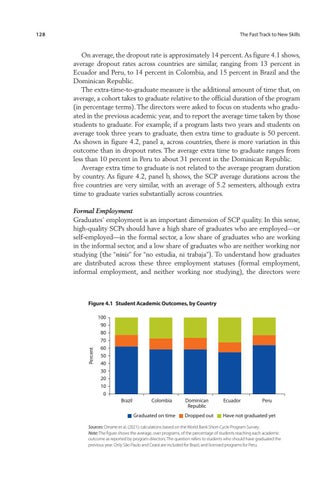128
The Fast Track to New Skills
On average, the dropout rate is approximately 14 percent. As figure 4.1 shows, average dropout rates across countries are similar, ranging from 13 percent in Ecuador and Peru, to 14 percent in Colombia, and 15 percent in Brazil and the Dominican Republic. The extra-time-to-graduate measure is the additional amount of time that, on average, a cohort takes to graduate relative to the official duration of the program (in percentage terms). The directors were asked to focus on students who graduated in the previous academic year, and to report the average time taken by those students to graduate. For example, if a program lasts two years and students on average took three years to graduate, then extra time to graduate is 50 percent. As shown in figure 4.2, panel a, across countries, there is more variation in this outcome than in dropout rates. The average extra time to graduate ranges from less than 10 percent in Peru to about 31 percent in the Dominican Republic. Average extra time to graduate is not related to the average program duration by country. As figure 4.2, panel b, shows, the SCP average durations across the five countries are very similar, with an average of 5.2 semesters, although extra time to graduate varies substantially across countries. Formal Employment Graduates’ employment is an important dimension of SCP quality. In this sense, high-quality SCPs should have a high share of graduates who are employed—or self-employed—in the formal sector, a low share of graduates who are working in the informal sector, and a low share of graduates who are neither working nor studying (the “ninis” for “no estudia, ni trabaja”). To understand how graduates are distributed across these three employment statuses (formal employment, informal employment, and neither working nor studying), the directors were
Percent
Figure 4.1 Student Academic Outcomes, by Country 100 90 80 70 60 50 40 30 20 10 0 Brazil
Colombia Graduated on time
Dominican Republic
Ecuador
Peru
Dropped out
Have not graduated yet
Sources: Dinarte et al. (2021); calculations based on the World Bank Short-Cycle Program Survey. Note: The figure shows the average, over programs, of the percentage of students reaching each academic outcome as reported by program directors. The question refers to students who should have graduated the previous year. Only São Paulo and Ceará are included for Brazil, and licensed programs for Peru.

